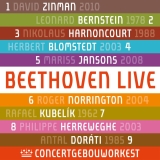 **** - Ludwig van Beethoven: 9 Symphonien; Concertgebouworkest Amsterdam, David Zinman (1), Leonard Bernstein (2), Nikolaus Harnoncourt (3), Herbert Blomstedt (4), Mariss Jansons (5), Roger Norrington (6), Carlos Kleiber (7), Philippe Herreweghe (8), Antal Dorati (9), Roberta Alexander, Jard van Nes, Horst Laubenthal, Leonard Mroz, Chor des Concertgebouworkest; 5 CDs RCO 19005; Radio Live Recordings 1978-2010, Veröffentlichung 20/11/2020 - Rezension von Remy Franck
**** - Ludwig van Beethoven: 9 Symphonien; Concertgebouworkest Amsterdam, David Zinman (1), Leonard Bernstein (2), Nikolaus Harnoncourt (3), Herbert Blomstedt (4), Mariss Jansons (5), Roger Norrington (6), Carlos Kleiber (7), Philippe Herreweghe (8), Antal Dorati (9), Roberta Alexander, Jard van Nes, Horst Laubenthal, Leonard Mroz, Chor des Concertgebouworkest; 5 CDs RCO 19005; Radio Live Recordings 1978-2010, Veröffentlichung 20/11/2020 - Rezension von Remy Franck
Aus dem Archiv der Radiomitschnitte hat das Concertgebouworkest Amsterdam eine Box mit allen Beethoven-Symphonien zusammengestellt. Der PR-Mitteilung des Orchesters zufolge waren die meisten dieser Aufnahmen bisher unveröffentlicht. Hier ist, was ich mir beim Abhören der neun Aufnahmen notiert habe.
Nr. 1 unter David Zinman (2010): Sehr nervöser erster Satz, viel Charme im zweiten und im dritten. Schwungvoll farbiges Finale.
Nr. 2 unter Leonard Bernstein (1978): eine etwas breitspurige, nicht besonders inspiriert dirigierte Zweite, die Bernstein nicht zum Ruhme gereicht.
Nr. 3 unter Nikolaus Harnoncourt (1988): Ein phänomenal pulsierender, frenetisch gesteigerter erster Satz, ein voll emotionaler Trauermarsch, viel Energie und drängendes, stets rhetorisches Musizieren im 3. Satz und im Finale.
Nr. 4 unter Herbert Blomstedt (2003): In dieser Vierten ist allein schon die Einleitung zum 1. Satz ein Ereignis. Im langsamen Satz hält man mehr als einmal den Atem an. Die beiden andern Sätze sind Modelle wahrhaft inspirierten und spontanen Musizierens auf höchstem Niveau.
Nr. 5 unter Mariss Jansons (2008): Nichts Neues unter der Sonne. Eine gute und spannungsvolle Aufführung, nicht mehr.
Nr. 6 unter Roger Norrington (2004): Spontan, frisch und enthusiastisch im ersten Satz, mit bezauberndem Charme im zweiten und im dritten. Ein atemberaubendes Klangschauspiel während des furchtbaren Gewitters führt zu den dankbaren und sehr inspirierenden Gefühlen des letzten Satzes.
Nr. 7 unter Carlos Kleiber (1983): Eine gute und durchgehend spannende Interpretation ohne besondere Höhepunkte.
Nr. 8 unter Philippe Herreweghe (2003): Eine Springball-Interpretation, kräftig akzentuiert und eher unattraktiv.
Nr. 9 unter Antal Dorati (1985): 70 Minuten habe ich mich gefragt, was die Kuratoren dieser Reihe dazu bewegt haben kann, diese Aufnahme in die Box zu nehmen. Dorati ist nicht wirklich inspiriert, das Orchester spielt nicht wirklich auf üblichem Niveau, die Solisten singen nicht wirklich gut und der Ton ist auch nicht wirklich zufriedenstellend. Wieso? Eine Antwort habe ich nicht. Und dass es von der Neunten nicht doch eine bessere Aufnahme in den Archiven des Concertgebouw geben sollte, kann ich mir nicht vorstellen.
Fazit: von den Neun sind zwei sehr gut, 3 und 6. Die Vierte ist herausragend.
The Concertgebouworkest Amsterdam has compiled a box of all Beethoven symphonies from their archive of radio recordings. According to the orchestra’s PR release, most of these recordings have never been released before. Here is what I noted down while listening to the nine recordings.
No. 1 under David Zinman (2010): Very nervous first movement, lots of charm in the second and third. Swinging colourful finale.
No. 2 under Leonard Bernstein (1978): a somewhat broad, not particularly inspired conducting. Not the best of Bernstein!
No. 3 under Nikolaus Harnoncourt (1988): a phenomenally pulsating, frenetically increased first movement, a fully emotional funeral march, a lot of energy and urgent, always rhetorical playing in the third movement and in the finale.
No. 4 under Herbert Blomstedt (2003): In this Fourth, the introduction to the first movement alone is an event. The Larghetto is breath-taking too. The other two movements are models of truly inspired and spontaneous playing at the highest level.
No. 5 under Mariss Jansons (2008): Nothing new under the sun. A good and exciting performance, not more.
No. 6 under Roger Norrington (2004): Spontaneous, fresh and enthusiastic in the first movement, with enchanting charm in the second and third. A breath-taking sound during the terrible thunderstorm leads to the thankful and very inspiring feelings of the last movement.
No. 7 under Carlos Kleiber (1983): A good and consistently exciting interpretation without any particular highlights.
No. 8 under Philippe Herreweghe (2003): A bouncing-ball interpretation, strongly accentuated and rather unattractive.
No. 9 under Antal Dorati (1985): Over 70 minutes I wondered what could have motivated the curators of this series to take this recording into the box. Dorati is not really inspired, the orchestra does not really play at the usual level, the soloists do not sing really well and the sound is not really satisfying either. Why? I have no answer. And I can’t imagine that there shouldn’t be a better recording of the Ninth in the archives of the Concertgebouw.
Conclusion: three of the nine performances two very good, 3 and 6. The Fourth is outstanding.
























